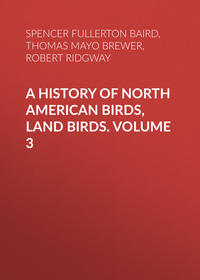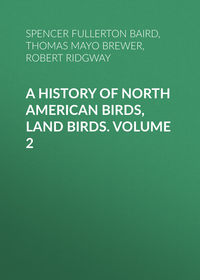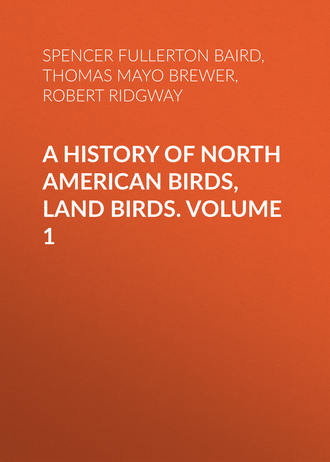 полная версия
полная версияA History of North American Birds, Land Birds. Volume 1
Dr. Kennerly, in his Report on the birds observed in the explorations under the charge of Lieutenant Whipple, speaks of meeting with these birds in the Rocky Mountains, in the vicinity of the Pueblo of Zuñi, in New Mexico. Thence, westward, he occasionally met with it, and usually in the cedar thickets.
Dr. Suckley mentions, in his Report on the Zoölogy of Washington Territory, obtaining a specimen of this species at Fort Steilacoom, April 28, 1856. It was very wild and difficult of approach. It was the only specimen obtained, and he considered it accidental west of the Cascade Mountains. Dr. Cooper, in the same Report, speaks of obtaining a specimen near Fort Laramie in October, where it seemed to be not uncommon.
Dr. Cooper, in his Birds of California, dwells with much emphasis upon the delightful melody of this species. Having always found them silent, and with habits like the Flycatchers’, he was quite unprepared to hear them singing in the Sierra Nevada, and, if he had not obtained the bird, would not have believed that one of this family was capable of singing with such power. Their song, he says, can be compared with nothing uttered by any other bird he has ever heard in the United States; for, he adds, it excels that of the Mocking-Bird in sweetness, besides being entirely original.
He met with only a few of this species among some junipers on the western slope near the summit, in September, 1863. He has always met with them nearly singly. Dr. Henry found them at Fort Webster, New Mexico, in large numbers, both in fall and in winter. Their home, Dr. Cooper thinks, seems to be in the vicinity of the great deserts of the central regions, or the cedar-covered mountains that intersect them.
Dr. Woodhouse obtained several specimens on the Zuñi Mountains in New Mexico, and from there westward found it exceedingly abundant. Its food seemed to be exclusively berries, and chiefly those of the cedar.
Dr. Coues also found these birds rare summer residents in Arizona, and confirms its possession of rare local powers, producing a rich, sweet, and finely modulated song.
Mr. Robert Ridgway, in accompanying Mr. King’s party of explorations, writes that he found this curious bird only occasionally, most frequently among the pines of the Sierra Nevada, and only once or twice among the mountains east of that range. In July, 1867, he found a nest of this bird. It was in a deep ravine on the western slope of the Sierras, at an altitude of five thousand feet. It was placed in a cavity of the rocks forming the perpendicular upper bank of a sluice constructed for mining purposes, through which ran the waters of a considerable mountain stream. The nest was about a foot above the water, and was as bulky as that of the Harporhynchus rufus, and similarly constructed, being composed almost entirely of sticks. It contained four young. When he approached, the female was much excited, flying before, or running on the ground in the manner of a true Thrush. Mr. Ridgway makes no mention of its song.
Mr. Lord met with these birds only once, and then at Colville, towards the end of November. All the leaves had fallen, the ground was deeply covered with snow, and the cold was intense. His attention was first attracted by hearing a low sweet song, not unlike that of the Song Thrush of Europe, which at that season was a most unusual sound. On looking around he saw about twenty of these birds perched on the top sprays of some white thorn-bushes. In their mode of darting off and returning again they reminded him of a Shrike. He shot six, and could detect no material difference in plumage between males and females. In the stomachs of those he opened were the remains of small coleopterous insects and a few haws.
Family LANIIDÆ.—The Shrikes
Char. Bill very powerful, strong, and much compressed, the tip abruptly hooked, deeply notched, and with a prominent tooth behind the notch; both mandibles distinctly notched, the upper with a distinct tooth behind, the lower with the point bent up. Tarsi longer than the middle toe, strongly scutellate. Primaries ten; first primary half the second, or shorter (occasionally wanting). Wings short, rounded; tail long and much graduated. Sides of tarsi with the plates divided on the outside.
Of this family only a single genus is known in North America.
Genus COLLURIO, VigorsCollurio, Vigors, Pr. Zoöl. Soc. 1831, 42. (Type, Lanius excubitor, L.)
Lanius, Auct. (not of Linnæus, whose type is L. cristatus).
Collyrio, G. R. Gray.—Baird, Birds N. Am. 1858, 323.
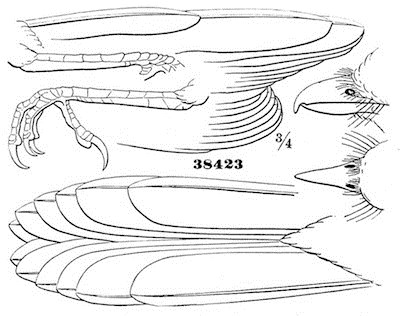
Collurio excubitoroides.
38423
Gen. Char. Feathers of forehead stiffened; base of bill, including nostrils, covered by bristly feathers directed forward. Bill shorter than the head, much compressed, and very powerful. Culmen decurved from base, the mandible abruptly bent down in a powerful hook with an acute lobe near the tip. Tip of lower mandible bent upwards in a hook; the gonys very convex. Rictus with long bristles. Legs stout; the tarsi rather short, and longer than the middle toe; the lateral equal; the claws all very sharp and much curved. Wings rounded; the first primary about half the second, which is equal to the sixth or seventh. Tail longer than the wings, much graduated, the feathers broad.
But few species of this genus belong to America, and these are confined to the northern portion. For the purpose of more readily identifying the species we present a brief diagnosis, and then furnish descriptions of all (including a European ally) in a single table.
SpeciesA. Outer webs of secondaries wholly white for basal half (mostly concealed by coverts, however). Upper eyelid white.
C. excubitor. 82 Nasal tufts grayish-white. In other respects, as regards colors, like excubitoroides. Wing, 4.20; tail, 4.00; tarsus, .95. Hab. Europe.
B. Outer webs of secondaries black to the base. Upper eyelids black.
a. White crescent on lower eyelid. Beneath with wavy bars of dusky in all stages. Tarsus less than 1.00; wing more than 4.50.
C. borealis. Upper half of nasal tufts white. Black spectacle bordered above the ear-coverts by hoary whitish. Scapulars and upper tail-coverts approaching white. Wing, 4.70; tail, 4.70; tarsus, .93. Hab. Arctic America; in winter south into United States, especially into the northern portions.
b. No white crescent on lower eyelid. Beneath without bars, except in young. Tarsus more than 1.00; wing less than 4.50.
C. ludovicianus. Black spectacle not bordered over ear-coverts with whitish.
White patch on primaries reaching nearly as far as end of first quill. Nasal tufts entirely blackBlack of lores and nasal tufts bordered above with hoary whitish. Tail white at base; inner webs of secondaries paler toward margin, but not abruptly white. Beneath entirely white, without ashy tinge laterally, or across breast. Axillars whitish. Upper tail-coverts ashy-white, scapulars pure white. Wing, 4.10; tail, 4.20; tarsus, 1.10; bill, .50. Hab. Western North America from Pacific Coast east to a little beyond the Mississippi, and to Texas. Nearly all of Mexico … var. excubitoroides.
Black of lores, etc., not bordered above by whitish. Tail black at base. Inner webs of secondaries pure white to the shaft on basal half. Beneath tinged with ashy laterally and across breast. Scapulars and upper tail-coverts hardly different from back. Bill, .60. Hab. California and fur countries … var. robustus.
White patch on primaries reaching only about half-way to end of first quill. Nasal tufts hoary-grayish aboveBlack of lores bordered above by hoary-whitish. Tail as in elegans,—secondaries as in excubitoroides. Beneath very strongly tinged with plumbeous laterally and across breast. Upper tail-coverts like the back, posterior scapulars only inclining to white. Axillars plumbeous. Wing, 3.80; tail, 3.95; tarsus, 1.00; bill, .50. Hab. South Atlantic and Gulf States … var. ludovicianus.
We now proceed to give a more detailed table of these species, and under the heading of each shall omit any further description:—
General Color. Bluish or plumbeous ash above; the outer edges of scapulars, sometimes the forehead and rump, paler. Beneath white, sometimes with waved transverse dark lines. A broad black stripe from side of upper bill through eye (extending more widely beneath than above it, sometimes wanting above) to end of ear-coverts. Wings (except lesser coverts) and tail black; the former with a white patch across base of primaries, sometimes on inner webs of secondaries; the secondaries tipped with white; the tail with broad white tips to the lateral feathers, the concealed bases of which are also usually white.
A. Black cheek-stripes involving eyelid only on upper border of eye, and not meeting across the forehead. A crescentic patch of white in the black below the eye; upper edge of black stripe behind the eye bordered by hoary whitish. Breast and belly always with distinct, transverse waved lines of dusky. Bill, when mature, entirely black. Length about 10 inches.
Above light ash. Upper tail-coverts and forehead much paler than the back, the former without waved lines. Axillars whitish.
Inner webs of secondaries paler towards edges, but not of well-defined white. Concealed bases of tail-feathers, except sixth, white. Tarsus shorter than the gape of mouth. Length, 10.00; extent, 14.50; wing, 4.70; tail, 4.70; bill above, .85; tarsus, .93 … borealis.
B. Black cheek-stripes not involving upper border of eye or upper eyelid, which is whitish, and not meeting across the forehead, its upper edge behind the eye with scarcely a lighter border. No patch of white on lower eyelid. Under parts unvaried white; in female obscurely waved. Base of under mandible whitish. Length about 9 inches.
Above light ash. Upper tail-coverts and forehead decidedly paler than the back. Axillars whitish.
Inner webs of all secondaries (except innermost) white to shaft, except for less than terminal half, which is black along the shaft. Concealed base of tail white, except on sixth feather. Tarsus equal to the gape … excubitor.
C. Black cheek-stripes involving upper eyelid, as in A, but without patch of white below the eye; meeting in a narrow, sometimes inconspicuous, line across the forehead, its upper edge behind the eye not bordered by lighter. Beneath plain white, or very obscurely waved in ludovicianus (the female?). Bill, when mature, entirely black. Length about 8.50 inches.
Above dark plumbeous-ash. Upper tail-coverts and forehead scarcely paler than the back. Sides and breast tinged with bluish-gray.
Black of loral space rather hoary along upper border. Frontal dark line inappreciable or wanting. Inner webs of secondaries paler only along the marginal half, and not abruptly white. Axillars plumbeous. Tail-feathers, except the innermost, with a concealed well-defined white patch at base, largest on the more exterior one. Bill from nostril, .50. Under parts often with very obscure faint waved lines (in the female?). White patch on wing reaching about to middle of first primary. Tarsus equal to the gape. Length, 8.50; wing, 3.72; tail, 4.10; bill above, .82; tarsus, 1.00 … ludovicianus.
Black of loral space without any lightening above it. Frontal black band well marked. Inner webs of secondaries (except innermost) pure white to shaft, except along rather more than terminal half, where the shaft is bordered by black. Axillars whitish. Tail-feathers black to base, except the loose fibres, which are grayish. Bill from nostril, .60. Under parts without waved lines. White patch on wing reaching nearly opposite to end of first primary. Tarsus about equal to the gape. Length, 8.75; wing, 4.20; tail, 4.40; bill above, 1.00; tarsus, 1.20 … elegans.
Above light ash-color. Upper tail-coverts and forehead much lighter than the back, the former sometimes almost white. Sides and breast generally nearly pure white.
Black of loral space with conspicuous hoary margin above it. Inner web of secondaries much as in C. ludovicianus. Axillars whitish. Tail-feathers with concealed white patch at bases of all the feathers. Bill from nostril about .50. No waved lines beneath. White patch on wing reaching nearly opposite to end of first primary. Tarsus longer than the gape. Length, 8.50; wing, 4.05; tail, 4.25; bill above, .83; tarsus, 1.12 … excubitoroides.
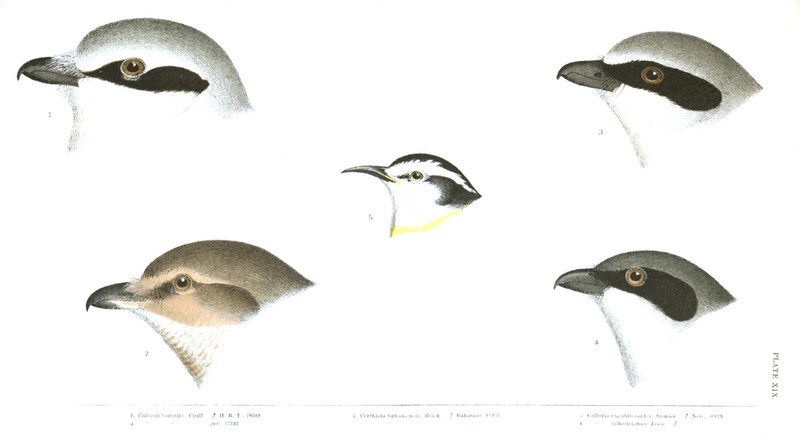
PLATE XIX.
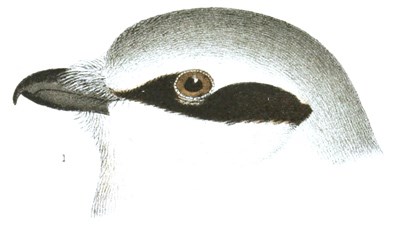
1. Collurio borealis, Vieill.♂ H. B. T., 19549.
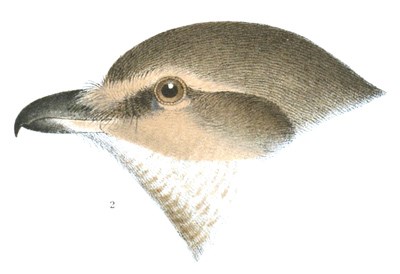
2. Collurio borealis, Vieill. juv., 17192.

3. Collurio excubitoroides, Swains. Neb., 38423.
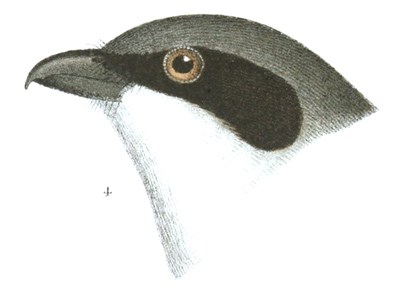
4. Collurio ludovicianus, Linn. ♂.

5. Certhiola bahamensis, Reich. ♂ Bahamas, 11951.
Collurio borealis, BairdGREAT NORTHERN SHRIKE, OR BUTCHER-BIRD
Lanius borealis, Viellot, Ois. Am. Sept. I, 1807, 90, pl. 1.—Sw.—Aud. Syn.—Ib. Birds Am. IV, 1842, 130, pl. ccxxxvi.—Cassin.—Max. Cab. Jour. VI, 1858, 190 (Upper Missouri).—Jones, Nat. Bermuda, 1857, 51 (Bermuda).—Dresser & Sharpe, P. Z. S. 1870, 590. Collyrio borealis, Baird, Birds N. Am. 1858, 324.—Cooper & Suckley, P. R. Rep. XII, II, 1860, 188 (Washington Territory).—Dall & Bannister, 280 (Alaska).—Samuels, Birds N. Eng. 268. Collurio borealis, Baird, Rev. Am. B. 1864, 440. Lanius excubitor, Forster, Phil. Trans. LXII, 1772, 382 (not of Linnæus).—Wilson, I, 1808, 74, pl. v, fig. 1. Lanius septentrionalis, Bon. Syn. 1828, 72 (not of Gmelin, which cannot be identified as an American species).—Cooper, Orn. Cal. 1, 1870, 137.—Cassin, Pr. A. N. Sc. 1857, 213.—Murray, ed. New Phil. Jour. XI, 1859, 223 (H. B. T.).
Hab. Whole of America north of United States; in winter south to Washington, St. Louis, Prescott (Arizona), and North California; Bermuda (winter, Jones).
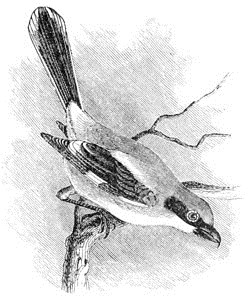
Collyrio excubitoroides.
The description of this and the succeeding species will be found on page 413. In winter, the colors, especially of the immature birds, are quite different from those described. The plumage of the adult, in winter, differs from that of spring as follows: the lores and nasal tufts are whitish, instead of pure, sharply defined black, with, however, some of the hair-like fibres blackish. The ash above is a little less clear, the white beneath less pure; the under mandible whitish at the base. An immature bird, in winter, has the ash above overlaid by a wash of reddish-brown, producing a prevailing uniform light-brown tint; the black on side of head is reduced to an obsolete patch on the ear-coverts. The dull white beneath is everywhere—sometimes even on the lower tail-coverts—covered with numerous bars of dusky, more sharply defined, and darker than in the adult.
Eastern specimens appear to have as much white on the rump as Western ones.
Habits. In the breeding-season this species of Shrike is found in all North America north of the United States, and is said to breed also within our territory, in mountainous districts. Such, at least, is the statement of Mr. Audubon, and Wilson leaves us to infer the same thing by giving a minute description of its nest and eggs. But Audubon may have confounded this species with the excubitoroides, and Wilson, apparently believing our species and the excubitor of Europe to be identical, may have had the nest and eggs of the European bird in view in his description. We know of a single recent instance in which this bird has bred within the limits of the United States, though it may breed in Northern and Eastern Maine. Mr. Boardman spoke of it as common only in winter, near Calais, but he has since met with its nest in New Brunswick, within twelve miles of St. Stephen. It was supposed by his informant to be the nest of the Canada Jay, but proved, on shooting the parent, to be that of the Northern Shrike. When found, it contained four eggs, but these had hatched out before it was secured. The nest was found on the last of April, and was built in a low spruce-tree. Mr. Boardman has since seen these birds in his neighborhood during the summer. Professor Verrill thinks it is only common in the autumn and winter in Western Maine. In Western Massachusetts, Mr. Allen cites it as not very common, but a regular winter visitant, from the last of October to the middle of April.
Mr. Ridgway met with it frequently in the neighborhood of Carson City during the winter, among the willows bordering the streams that flow from the mountains. Dr. Coues also found it as far south as Arizona, though Mr. Dresser did not meet with any in Texas, nor did Dr. Woodhouse notice any in his expedition to the Zuñi. Captain Feilner found this species common, in the colder months, in the northeastern portions of California, and Dr. Cooper gives it as abundant at the Columbia River in October.
Mr. Audubon further states that in severe winters he has met with it as far south as Natchez on the Mississippi. It is also not uncommon in Kentucky during the same season, but he never met with it near the seaboard.
Mr. Kennicott’s memoranda in reference to this species are to the effect that he observed one individual at Fort Simpson, September 23, and again October 22, but on no other occasion. Both of these specimens, when first observed, were singing. Their notes, he states, were low and irregular, but were varied and quite musical. Captain Blakiston found these birds winter residents on the Saskatchewan.
In the fall and winter of 1871, a pair of these birds was attracted to the Common, in Boston, by the large number of half-domesticated European Sparrows. For a while they made daily inroads upon these favorites, killing one or more for several days in succession. They appeared to keep themselves secreted most of the time, showing themselves each day early in the forenoon, and pouncing upon their victims, unaware of their near presence, in the manner of a Hawk, aiming always at the heads, which were torn off and devoured; generally the headless remains were left uneaten. In one instance where a Sparrow had been struck on the back, an ugly wound was made, the bird escaped alive, and was soon after seen, in the middle of Tremont Street, apparently not seriously injured. These Shrikes were so bold and destructive that pains had to be taken to watch for and shoot them. Three were killed, on different days, and each with a dead Sparrow in its claws, upon which it was feasting when shot.
Both Mr. Audubon and Mr. Nuttall refer to this Shrike’s imitating the cries of other birds, apparently to decoy them within its reach. The former has heard it utter cries like those of the Sparrow screaming in the claws of a Hawk, to induce them to come out of their coverts and rescue their suffering fellows, and has seen them dart suddenly into a thicket in pursuit of one, from which would soon issue the real cries of the bird it had seized. Nuttall states that in some parts of New England this Shrike is called a Mocking-Bird, on account of its imitations of the notes of smaller birds. Its more usual note resembles the discordant creaking of a signboard hinge. He also states that it has been known to mimic the quacking of ducks, so that these would answer to it as to a decoy. He heard one of these birds, as late as November 10, uttering a low and soft warble, resembling that of the Song Sparrow, immediately after changing it to the notes of the Catbird.
When in pursuit of small birds, it will dart down with closed wings, in the manner of a Hawk, and seldom fails to obtain the object of its pursuit, following it with rapidity and pertinacity through the thickets in which it seeks shelter. When it seizes its prey, it alights on its back, and tears open its head.
Its bold audacity and perseverance are quite remarkable, and are often displayed, in the fall, in the manner in which it will enter an apartment through an open window and attack a Canary, even in the presence of members of the family. It rarely fails, if it gains access to the cage, to destroy its inmate before the latter can be rescued by the intervention of those present, and only by great promptness in sheltering the cage. In one instance the writer was sitting at a closed window reading, with a Canary hanging above him. Suddenly there was a severe blow struck at the pane of glass near the cage, and the frightened Canary uttered cries of alarm and fell to the bottom of its cage. The cause was soon explained. A Shrike had dashed upon the bird, unconscious of the intervening glass, and was stretched upon the snow under the window, stunned by the blow. He revived when taken up, and lived several days, was sullen, but tame, and utterly devoid of fear. He refused raw meat, but eagerly tore in pieces and devoured small birds when given to him. His tameness and indifference to our presence may have been occasioned by stupor arising from his injury. In another case a Shrike made a similar attack, but escaped unharmed, and though he remained about the house several days, was too wary to allow himself to be decoyed within gunshot.
A nest of the Northern Shrike, containing six eggs, was obtained by R. R. McFarlane, at Anderson River Fort, June 11, 1863. This is in many respects in striking contrast with the nests of its kindred species of the Southern States, far exceeding them in its relative size, in elaborate finish and warmth. It is altogether a remarkable example of what are known as felted nests, where various materials are most elaborately worked together into a homogeneous and symmetrical whole. It is seven inches in diameter and three and a half in height. The cavity is proportionately large and deep, having a diameter of four and a half inches, and a depth of two. Except the base, which is composed of a few twigs and stalks of coarser plants, the nest is made entirely of warm and soft materials, most elaborately interworked together. These materials are feathers from various birds, fine down of the Eider and other ducks, fine mosses and lichens, slender stems, grasses, etc., and are skilfully and artistically wrought into a beautiful and symmetrical nest, strengthened by the interposition of a few slender twigs and stems without affecting the general felt-like character of the whole. The egg measures 1.10 inches by .80, and is of a light greenish ground, marbled and streaked with blotches of obscure-purple, clay-color, and rufous-brown.
Sir John Richardson found this a by no means uncommon bird in the woody districts, at least as far as the sixteenth parallel. On account of its resemblance to the Canada Jay, the Indians called it the “White Whiskey-John.” It remains all winter in the fur regions, but is much more numerous in summer. He states that the nest is built in the fork of a tree, of dry grass and lichens neatly intertwined, and lined with feathers.
Collurio ludovicianus, BairdSOUTHERN SHRIKE; LOGGERHEADLanius ludovicianus, Linn. Syst. Nat. 1766, 134 (based on Lanius ludovicianus, Brisson, II, 162, tab. xv, fig. 2).—Aud. Orn. Biog. I, 1831, 300, pl. xxxvii.—Ib. Birds Am. IV, pl. ccxxxvii.—Cassin, Pr. A. N. Sc. 1857, 213. Collyrio ludovicianus, Baird, Birds N. Am. 1858, 325. Collurio ludov. Baird, Rev. Am. B. 1864, 443. Lanius ardosiaceus, Vieillot, Ois. Am. Sept. I, 1807, 81, pl. li. Lanius carolinensis, Wils. Am. Orn. III, 1811, 57, pl. xxii, fig. 5.




